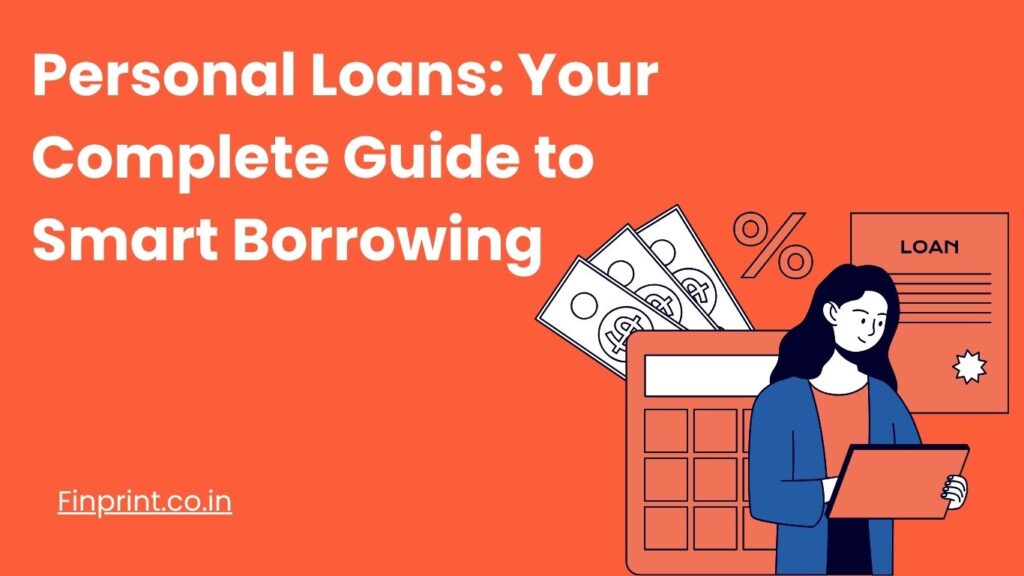Personal Loans: Your Complete Guide to Smart Borrowing
I. Introduction
Why Personal Loans Matter in Today’s Financial Landscape
 Personal loans are today among the popular financial tools for individuals seeking to access fast and easy funding in today’s hectic environment. To finance medical emergencies, home renovations, education, or debt consolidation, a personal loan is the economic breathing space you need—all without dipping into your savings.
Personal loans are today among the popular financial tools for individuals seeking to access fast and easy funding in today’s hectic environment. To finance medical emergencies, home renovations, education, or debt consolidation, a personal loan is the economic breathing space you need—all without dipping into your savings.
Personal loans are special because they’re unsecured, meaning you don’t have to mortgage something like your house or jewelry. That means they’re open to salaried employees, businessmen and women, and even to self-employed individuals.
Who This Guide Is For: First-Time Borrowers, Business Owners, and Homeowners
This guide is designed for anyone planning to take a personal loan in India—be it your first loan or part of your financial strategy. Whether you’re a first-time borrower, a small business owner, or a homeowner, you’ll find practical insights on how to make informed borrowing decisions.
What You’ll Learn About Personal Loan Success
In this blog, you’ll learn:
- How personal loans work and their key features
- The application and approval process
- Smart uses of personal loans
- Common mistakes to avoid and borrowing responsibly
II. Understanding Personal Loans: The Fundamentals
What Makes Personal Loans Different from Other Types of Financing
Unlike credit cards or home loans, personal loans provide lump sums with clear repayment terms. You borrow a fixed sum and repay it with equal monthly instalments (EMIs) in a fixed tenure of 1 to 5 years.
These loans are versatile—You can use them for almost any purpose. And since they are not secured, they are processed faster than secured loans.
Types of Personal Loans That Can Be Availed
Indian banks and NBFCs offer a range of types of personal loans that are designed to meet different needs:
- Personal Loan for Salaried Employees – Offered by banks like HDFC Bank
, ICICI Bank, and SBI, these are most suitable for individuals with regular monthly salary. - Self-Employed Personal Loans – For professionals like doctors, CAs, and businessmen.
- Wedding and Travel Loans – Short-term loans for managing grand events or vacations.
- Debt Consolidation Loans – Consolidate a bunch of high-interest loans into a single payable EMI.
Secured vs. Unsecured Options
- Secured Personal Loans – Collateral is needed (like FD or property). Lower interest rates.
- Unsecured Personal Loans – No collateral is needed but the rates are slightly higher.
Fixed vs. Variable Rate Loans
- Fixed-rate Loans: EMI remains the same throughout the tenure.
- Variable-rate Loans: Interest keeps changing based on market fluctuation.
Key Loan Features that Influence Your Decision
1. Interest Rates: How Your Cost Is Determined
Interest rates are between 9% to 24% p.a., depending on:
- Credit score
- Employment stability
- Income level
- Bank relationship
Top Indian banks and NBFCs that offer competitive personal loan interest rates are:
State Bank of India (SBI) – starting around 11% p.a.
HDFC Bank – from 10.5% p.a.
ICICI Bank – from 10.75% p.a.
Axis Bank – from 11% p.a.
Bajaj Finserv – from 12% p.a.
2. Loan Amounts: How Much Can You Borrow
Most Indian banks lend between ₹50,000 and ₹40 lakh, depending on income and credit history.
3. Repayment Terms: Finding Your Ideal Timeline
Choose a tenure of 12 to 60 months. The longer the tenure, the lower the EMI but the higher the interest paid.
III. Application Process: How to Easily Get a Personal Loan
Pre-Application Preparation: Documents and Credit Check
Make sure you ready the following prior to applying:
- KYC Documents – Aadhaar, PAN, or passport
- Income Proof – Salary slips or ITR for self-employed
- Bank Statements – Last 6 months
- Employment Proof – Offer letter or business registration
Also, check your credit score (CIBIL). A credit score of 750 and above significantly increases the approval chances and reduces the interest rates.
Step-by-Step Application Walkthrough
- Check Eligibility: Use bank calculators to estimate loan eligibility.
- Compare Offers: Look for banks offering pre-approved loans.
- Submit Application: Fill in form online or approach the nearest branch.
- Verification: Bank verifies documents and creditworthiness.
- Approval & Disbursal: Money is transferred directly into your account—generally within 24–48 hours for pre-approved customers.
What Lenders Want in Borrowers
- Consistent employment and income
- Good repayment history
- Low credit utilization ratio
- Standing obligations of loan
Timeline: Application to Funding
Typically, it takes:
- Online loans: 1–2 working days
- Offline applications: 3–7 working days
Tips for First-Time Applicants
- Do not apply to multiple banks at the same time.
- Choose a bank where you already hold a salary or savings account.
- Maintain your debt-to-income level low (preferably below 40%).
IV. Common Uses for Personal Loans: When Should You Consider One?
Debt Consolidation Strategies
Settle multiple debts—like credit cards and small loans—via a single EMI. This simplifies management and reduces interest outgo.
Home Improvement and Renovation Projects
Upgrade your home interiors, kitchen, or furniture without disturbing your savings. Banks like HDFC Bank
and ICICI Bank
even offer personal loans for home renovation.
Small Business Funding Opportunities
If you’re a self-employed professional, a personal loan can help with:
- Expanding inventory
- Upgrading equipment
- Managing cash flow
Emergency Expenses and Unexpected Costs
- Medical emergencies, car repairs, or urgent travel—personal loans provide quick liquidity when needed most.
- Major Life Events and Planned Purchases
- Pay weddings, college, or major appliances with no financial stress.
V. Warnings and Precautions: What You Should Know Before Taking a Personal Loan
Hidden Fees and Charges to Watch Out For
Before you sign:
Processing Fees: Usually 1%–2% of the loan.
- Prepayment Charges: If you repay your loan before the period.
- Late Payment Penalties: Could end up costing you a lot more.
How it Impacts Your Credit Score
Missing EMIs or delayed payments negatively affect your CIBIL score, reducing future borrowing capacity.
Alternatives to Avail First
Before you take a personal loan, do the following:
- Overdraft Facility on salary account
- Top-up on existing loans
- Loan against FD or property (LAP) for lower interest rates
Red Flags: When Personal Loans Aren’t Right
- When your income is unstable
- When you already have multiple EMIs
- When you’re planning to invest borrowed money in high-risk investments
VI. Conclusion
Key Takeaways for Smart Personal Loan Decisions
Personal loans are a good financial tool—when borrowed wisely. They offer flexibility, instant access to funds, and no use restriction. But smart borrowing requires discipline: compare offers, maintain a good credit score, and understand the fine print.
Your Next Steps: Action Plan for Loan Success
Assess your financial need and repayment capacity.
- Check your credit score.
- Compare offers from top banks like SBI, HDFC Bank, ICICI Bank, and Axis Bank.
- Apply online for faster approval and disbursal.
Resources for Continued Financial Education
Keep up with reliable sources such as:
- RBI – Personal Loan Guidelines
- FinPrint Finance Blog for the latest banking insights
- Bank websites for current offers and interest rates


